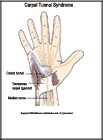
Carpal Tunnel Syndrome
What is carpal tunnel syndrome?
Carpal tunnel syndrome is a common, painful disorder of the wrist and hand.
How does it occur?
Carpal tunnel syndrome is caused by pressure on the median nerve in your wrist. People who use their hands and wrists repeatedly in the same way (for example, illustrators, carpenters, and assembly-line workers) tend to develop carpal tunnel syndrome.
Pressure on the nerve may also be caused by a fracture or other injury, which may cause inflammation and swelling. In addition, pressure may be caused by inflammation and swelling associated with arthritis, diabetes, and hypothyroidism. Carpal tunnel syndrome can also occur during pregnancy.
What are the symptoms?
The symptoms include:
- pain, numbness, or tingling in your hand and wrist, especially in the thumb and index and middle fingers; pain may radiate up into the forearm
- increased pain with increased use of your hand, such as when you are driving or reading the newspaper
- increased pain at night
- weak grip and tendency to drop objects held in the hand
- sensitivity to cold
- muscle deterioration especially in the thumb (in later stages).
How is it diagnosed?
Your health care provider will review your symptoms, examine you, and discuss the ways you use your hands. He or she may also do the following tests:
- Your provider may tap the inside middle of your wrist over the median nerve. You may feel pain or a sensation like an electric shock.
- You may be asked to bend your wrist down for one minute to see if this causes symptoms.
- Your provider may arrange to test the response of your nerves and muscles to electrical stimulation.
How is it treated?
If you have a disease that is causing carpal tunnel syndrome (such as rheumatoid arthritis), treatment of the disease may relieve your symptoms.
Other treatment focuses on relieving irritation and pressure on the nerve in your wrist. To relieve pressure your health care provider may suggest:
- restricting use of your hand or changing the way you use it
- wearing a wrist splint
- exercises.
Your provider may prescribe an oral cortisonelike medicine or a nonsteroidal anti-inflammatory medicine, such as ibuprofen. He or she may recommend an injection of a cortisonelike medicine into the carpal tunnel area. In some cases surgery may be necessary.
How long will the effects last?
How long the symptoms of carpal tunnel syndrome last depends on the cause and your response to treatment. Sometimes the symptoms disappear without any treatment, or they may be relieved by nonsurgical treatment. Surgery may be necessary to relieve the symptoms if they do not respond to treatment or they get worse. Surgery usually relieves the symptoms, especially if there is no permanent damage to the nerve.
Symptoms of carpal tunnel syndrome that occur during pregnancy usually disappear following delivery.
How can I take care of myself?
Follow your health care provider's recommendations. Also try the following:
- Elevate your arm with pillows when you lie down.
- Avoid activities that overuse your hand.
- Find a different way to use your hand by using another tool or try to use the other hand.
- Avoid bending your wrists.
When can I return to my sport or activity?
The goal of rehabilitation is to return you to your sport or activity as soon as is safely possible. If you return too soon you may worsen your injury, which could lead to permanent damage. Everyone recovers from injury at a different rate. Return to your sport will be determined by how soon your wrist recovers, not by how many days or weeks it has been since your injury occurred. In general, the longer you have symptoms before you start treatment, the longer it will take to get better.
You may return to your sport or activity when you are able to painlessly grip objects like a tennis racquet, bat, golf club, or bicycle handlebars. In sports such as gymnastics, it is important that you can bear weight on your wrist without pain. You must have full range of motion and strength of your wrist.
What can I do to help prevent carpal tunnel syndrome?
If you do very repetitive work with your hands, make sure that your hands and wrists are comfortable when you are using them. Take regular breaks from the repetitive motion. Avoid resting your wrists on hard or ridged surfaces for prolonged periods.
If you have a disease that is associated with carpal tunnel syndrome, effective treatment of the disease might help prevent this condition.
In some cases the cause is not known and carpal tunnel syndrome cannot be prevented.

